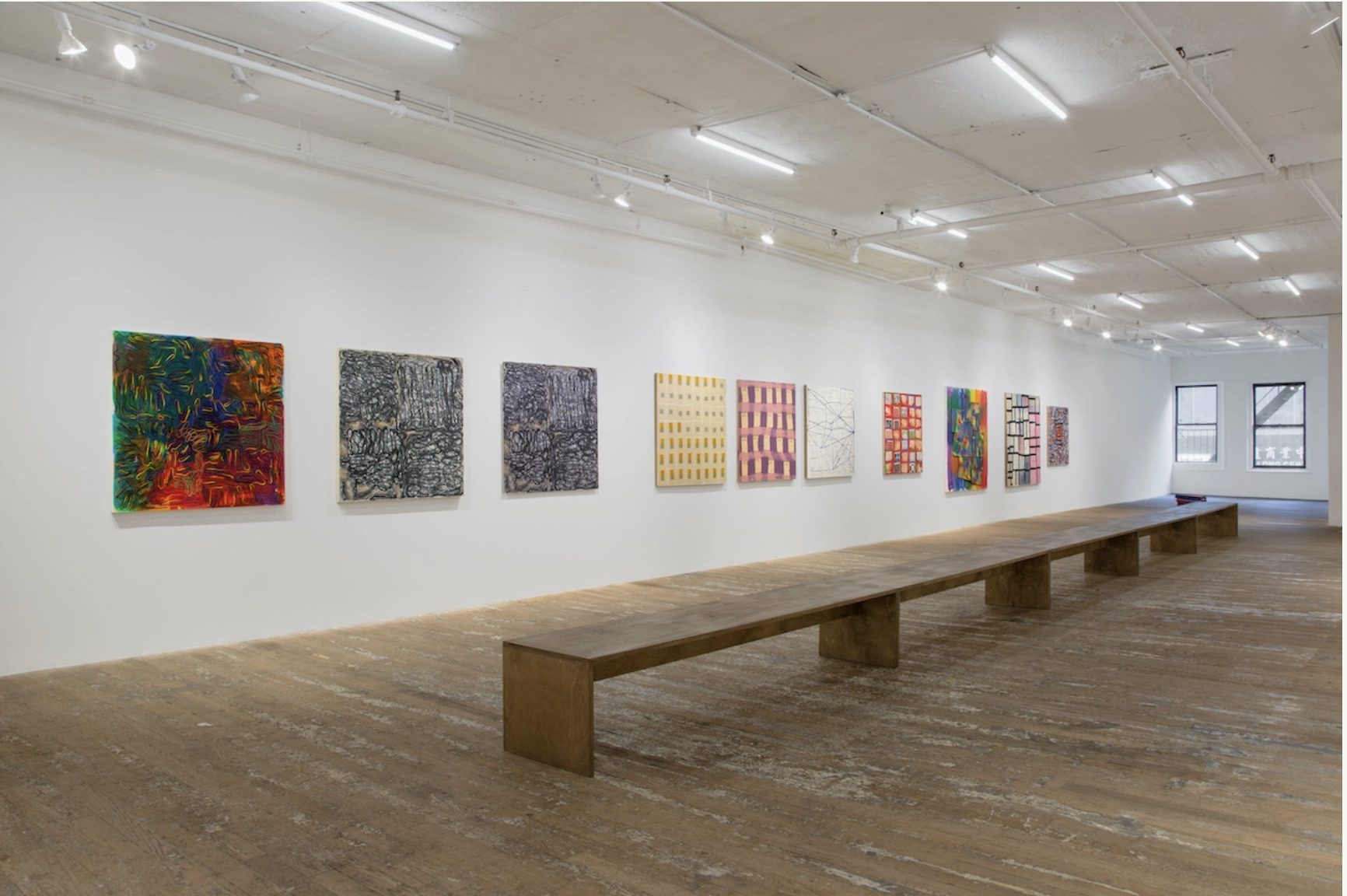Spinning Wheels: Rochelle Feinstein at Bridget Donahue and Candice Madey

Cramped boxes, unsolvable mazes, numbing repetitions—these are the building blocks of Rochelle Feinstein’s comedy. The paintings in “You Again”—a multicity exhibition, spanning more than thirty years, whose New York hosts are Bridget Donahue and Candice Madey—are ugly by almost any definition: they’re too loud, too busy, too similar. At her frequent best, though, Feinstein tops a dead end with an ever-so-slightly deader one and then another, until her work has gone from dull to annoying to silly to sardonic to ingenious to alive.
Consider Brainchild (1993), one of her many paintings featuring yarn. The strand crawls around the canvas like an ant trapped in an ant farm. But because Feinstein has painted over the yarn and the canvas at the same time, the whole mess alternating white and black and grayish-blue, it takes a while to notice the yarn is yarn, not paint. The image seems doubly dead-ended: first, because the yarn leads nowhere and, second, because the yarn barely registers at all. And yet these two dead ends in some sense cancel each other out—it’s hard for something to lead nowhere if it’s hardly there in the first place. The double negative starts to feel like a positive. Recently, Feinstein doubled her own double negative: at a glance, Scanned (2021) looks like an exact replica of Brainchild, but it’s actually a texture-less, UV-on-aluminum print of the earlier image. Side by side with its sibling, Brainchild doesn’t seem so dull anymore—the remake induces nostalgia for the good old days of yarn and paint.
The word “remake” is more appropriate here than it seems. Feinstein, with her joyless imagery repeating ad nauseam, is one of the fiercest parodists of American culture since Philip Guston, who slapped an oversize schnoz on Nixon. This takes time to appreciate, since she’s not primarily concerned with re-creating specific cultural artifacts (though eagle-eyed gallerygoers will notice a movie poster for Naked Gun 2½: The Smell of Fear, from 1991). Instead, she’s after a pop-ish, distinctly contemporary tone: a combination of giddiness, amusement, boredom, cheapness, nihilism, and nausea that should be familiar to anyone who thought “Tiger King” was just OK but watched it all anyway.
Many of the two dozen or so pieces hanging in New York look bright and cheery. But it’s a hollow, sugary cheer; the title of one painting, Same Shit Different Day (1990), nicely sums up Feinstein’s sense of humor and her sense of contemporary American culture. In Upcycled (2021), a vaguely circular arrangement of cardboard is held together with yarn, mounted on linen, and slathered in acrylics. The cardboard centerpiece is intentionally too big for its frame, and the ROYGBIV palette is intentionally too shrill. By dialing everything up to 11, Feinstein suggests a range of cultural and political associations (a Google logo, a recycling sign, a rainbow of diversity half-dissolved, a dash of handmade craft in a mechanized world) without leaning too hard on any one. Yet the target of this frazzled, overstuffed satire is hard to miss: you can practically smell the remote workers watching Netflix in their pajamas, nervously buying products they’ll never use. The cardboard, not coincidentally, came from Amazon delivery boxes.
Too much and too many crammed into too little space, a prison disguised as a rainbow—if you don’t think this sounds like America, I envy you. And while paintings depicting the “sick soul of the USA” have become somewhat de rigueur since November 2016, I can’t think of a recent example as deliciously concise as Someone Else’s Country (2022). Feinstein does Jasper Johns one better, reimagining America as a filthy jumble of state-like shapes squished together—she makes the Land of Liberty look as boxed-in and used-up as a cube of compacted garbage. Same shit, indeed.
